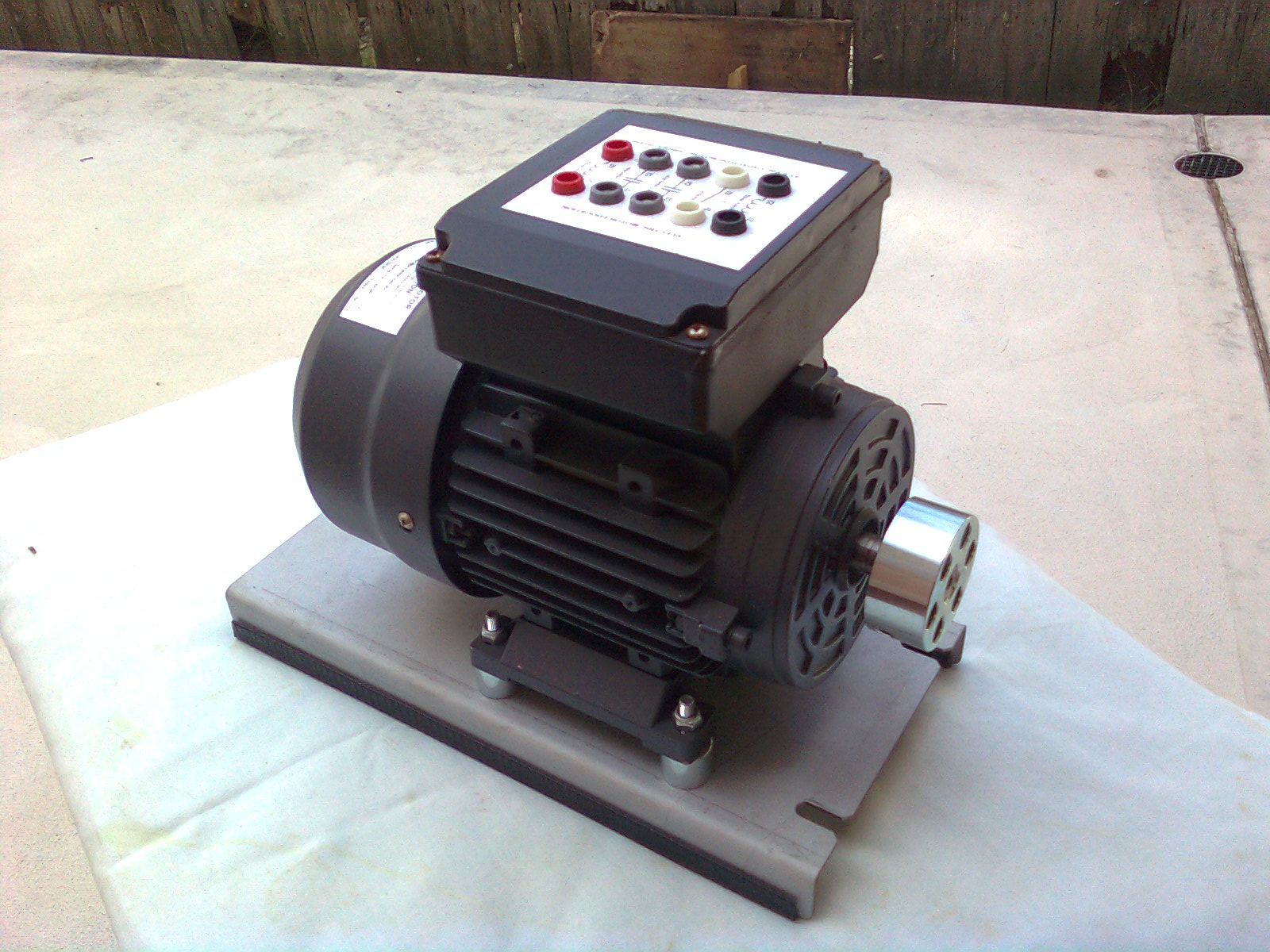Please Note: Prices subject to change without notice
71-1-H100-A : Motor - Single Phase, 44W, 4 pole, 41.5 Vac, 50Hz, SCIM
Price: $610 + Freight & handling + GST
This is a 41.5 Vac 50Hz, single phase, 4 pole, dual capacitor motor(split-phase-shaded-pole-motor)
This motor has ALL ten(10) of its internal component leads terminated at its terminal box with 4mm sockets (i.e. main & auxiliary winding, cut-out switch and both capacitors) thus enabling the student to connect and test the motor in any of the following modes;
- Capacitor “START” motor, Capacitor “RUN” (2 or Dual Capacitor motor) 180420-1Cap S&R CCT Diag.Issue Apdf
- Capacitor “Start” Motor 180420-2 Cap S CCT Diag.Issue Apdf
- Capacitor ”Start” – Adjustment of Starting Torque using Capacitor External Bank 71-1-CT001 71-1-CT001 CapStart Torque Diag
- 140306 circle diagram issue A
- Capacitor “RUN” motor or Permanent-Split-Capacitor(PSC);180420-3 Cap R CCT Diag
- Also, as both the Main(or Run) and Auxiliary(or Start) winding are wound with very similar numbers of turns & wire gauge, the motor may be connected to operate as a “REVERSING” PSC motor.180420-4 Cap R Reverse CCT Diag
- Power factor (pf) correction in-conjunction with Capacitor External Bank 71-1-Cpf001 71-1-Cpf001 CapStart pf correction Diag
- pf correction table
HANDS-ON : The motors designed low shaft output of 44W enables the student the grip the metal shaft mounted coupling with their hand and stall (Locked-Rotor) the shaft. Thus, the student is is able to physically feel the different starting torques predicted by their theory, i.e.:
- “Very-High” starting torque of the capacitor “START” motor; and
- “Low” starting torque of the capacitor “RUN” motor.
Logic behind the choice of 41.5 Vac for the single phase motor
Ideally, to conform with the 3ph, 41.5/24.0 Vac, 4 wire(3ph+E) Concept, it would have been preferable to have had the single phase motor operating on 24 Vac (i.e. phase to neutral).
Unfortunately, in practice, this proved nonviable on both economic and practical grounds. Mainly due to the size and cost of the capacitors but also due to the higher currents required.
However, in hindsight, this has proved to be a teaching advantage. As it highlights the (not very well understood) fact that a single phase supply is obtained from between two(2) points of potential difference i.e. not exclusively between phase & neutral but also between any two(2) phases!
For example:
- In a “Separated-Extra-Low-Voltage”(SELV) supply. i.e. between to actives;
- The use of a 415 Vac ‘single’ phase condenser fan motor in a 3ph, domestic air conditioners (phase to phase) to eliminate the need for a neutral conductor; or
- The use of a 415 Vac ‘single’ phase cooling fan motor in industrial welders. This enables the welder to be plugged into any Common/Normal standard ‘4 pin’(3ph+E) 3 phase outlet without concern of different phase sequences which would cause a 3ph motor to rotate in the wrong direction. As well as again, eliminating the need for a neutral conductor which would require the use of a “NOT-Common” 5 pin(3ph+N+E) 3ph plug & socket outlet
Note, the direction of single phase motors is ‘factory preset’ and independent of phase sequence. Hence, this is the MAIN reason why ALL domestic appliance motors are single phase.
The latter two examples are commonly met in industry. AND, all to frequently, due to lack of knowledge and understanding a failed 415V single phase motor is replaced with a 240V single phase motor. Which to the annoyance of the customer, in turn, fails after a short period of operation!

